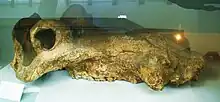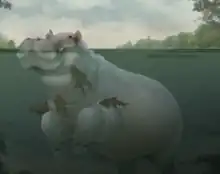Hippopotamus gorgops
Hippopotamus gorgops is an extinct species of Hippopotamus known from remains found in Northern and Eastern Africa as well as the Levant. It first appeared during the late Pliocene-Early Pleistocene, and became extinct during the early Middle Pleistocene.[1]
| Hippopotamus gorgops Temporal range: | |
|---|---|
 | |
| Scientific classification | |
| Domain: | Eukaryota |
| Kingdom: | Animalia |
| Phylum: | Chordata |
| Class: | Mammalia |
| Order: | Artiodactyla |
| Family: | Hippopotamidae |
| Genus: | Hippopotamus |
| Species: | †H. gorgops |
| Binomial name | |
| †Hippopotamus gorgops Dietrich, 1928 | |
Taxonomy
The species was described by German scientist Wilhelm Otto Dietrich in 1928.[2] It is closely related and possibly ancestral to the European species Hippopotamus antiquus.[3]
Distribution
Hippopotamus gorgops is known from remains found across Northern and Eastern Africa, spanning from the Late Pliocene-Early Pleistocene boundary to the early Middle Pleistocene.[1] Remains assigned to H. gorgops alongside the species H. behemoth are known from the Ubeidiya locality in Israel, dating to approximately 1.6 million years ago, with some authors suggesting that H. behemoth is actually a synonym of H. gorgops, given their similar morphology.[4][5]
Description

H. gorgops grew substantially larger than the living hippopotamus (H. amphibius),[6] with an estimated body mass of over 4,000 kilograms (8,800 lb).[7] In comparison to H. amphibius, the orbits and nasal openings are elevated higher above the rest of the skull, with the temporal fossa being shorter, resulting in the distance between the orbits and occiput being shorter. This likely meant a more forward attachment of the temporal muscles.[1] The nuchal and sagittal crests were also proportionally taller, and the palate was elongate.[8] In life H. gorgops would have likely greatly resembled H. amphibius.[1]
Ecology
Isotopic analysis of specimens from the Lake Turkana Basin suggests a high consumption of C4 plants.[9] For specimens from Olduvai Gorge in Tanzania, dental microwear suggests a mixed feeding diet (including both browse and grass), while mesowear suggests a largely grazing diet.[10] The elevated orbits have led to suggestions of a more aquatic lifestyle than H. amphibius,[11] though its robust limbs indicate that it was probably capable of moving efficiently on land, like H. amphibius.[8]
Relationship with humans
Remains with cut or fracture marks from sites across Africa from the Early Pleistocene indicate that H. gorgops was butchered by archaic humans.[12][13][14] These include El-Kherba in Algeria, dating to around 1.8 million years ago (mya),[14] Kilombe caldera in Kenya, dating to around 1.76 mya,[13] and the Buia site in Eritrea dating to the late Early Pleistocene,[12] around 1 mya.[8] Often at these sites tools from the Oldowan industry are present.[13][14] At Kilombe and Buia, it is unclear whether the hippos were hunted or scavenged.[12][13] It is unlikely that healthy adult individuals were hunted, as with living hippopotamuses, they were likely dangerous.[1]
References
- van der Made J, Sahnouni M & Boulaghraief K. 2017. Hippopotamus gorgops from El Kherba (Algeria) and the context of its biogeography. In Proceedings of the II Meeting of African Prehistory: Burgos 15-16 April, 2015, Sahnouni M, Semaw S, Rios Garaizar J (eds). CENIEH: Burgos; 135–169.
- Dietrich, W. O. (1928). Pleistocäne Deutsch–Ostafrikanische Hippopotamus–reste. Wissenschaftliche Ergebnisse des Oldoway Expedetion Herausgeben Von Prof. Dr. Reck, 3: 3–41.
- Martino, Roberta; Ríos, Maria Ibanez; Mateus, Octavio; Pandolfi, Luca (December 2022). "Taxonomy, chronology, and dispersal patterns of Western European Quaternary hippopotamuses: New insight from Portuguese fossil material". Quaternary International: S1040618222003901. doi:10.1016/j.quaint.2022.12.010.
- TCHERNOV, E (1986). "Les mammifères du Pleistocène inférieur de la vallée du Jourdain à Oubeidiyeh". Israel J. Earth Sci. 36: 3–36.
- Martínez-Navarro, B (2010). "The fossil Bovidae (Artiodactyla, Mammalia) from Gesher Benot Ya'aqov, Israel: Out of Africa during the early-middle Pleistocene transition" (PDF). J. Hum. Evol. 60: 375–386 – via Research Gate.
- Chaix L, Faure M, Guérin C, Honegger M. Kaddanarti, a Lower Pleistocene Assemblage from Northern Sudan. In: Krzyżaniak L, Kroeper K, Kobusiewicz M, editors. Recent Research into the Stone Age of Northeastern Africa. Poznań: Poznań Archaeological Museum; 2000. p. 33–46.
- Hutchinson, John R. (2021-06-01). "The evolutionary biomechanics of locomotor function in giant land animals". Journal of Experimental Biology. 224 (11). doi:10.1242/jeb.217463. ISSN 0022-0949. PMC 8214834. PMID 34100541.
- MartíNez-Navarro, Bienvenido; Pandolfi, Luca; Medin, Tsegai; Libsekal, Yosief; Ghinassi, Massimiliano; Papini, Mauro; Rook, Lorenzo (2022-02-22). "The ontogenetic pattern of Hippopotamus gorgops Dietrich, 1928 revealed by a juvenile cranium from the one-million-years-old paleoanthropological site of Buia (Eritrea)". Comptes Rendus Palevol (7). doi:10.5852/cr-palevol2022v21a7. ISSN 1777-571X.
- Harris, J. M.; Cerling, T. E.; Leakey, M. G.; Passey, B. H. (July 2008). "Stable isotope ecology of fossil hippopotamids from the Lake Turkana Basin of East Africa". Journal of Zoology. 275 (3): 323–331. doi:10.1111/j.1469-7998.2008.00444.x. ISSN 0952-8369.
- Uno, Kevin T.; Rivals, Florent; Bibi, Faysal; Pante, Michael; Njau, Jackson; de la Torre, Ignacio (July 2018). "Large mammal diets and paleoecology across the Oldowan–Acheulean transition at Olduvai Gorge, Tanzania from stable isotope and tooth wear analyses". Journal of Human Evolution. 120: 76–91. doi:10.1016/j.jhevol.2018.01.002.
- Pandolfi, Luca; Martino, Roberta; Rook, Lorenzo; Piras, Paolo (2020-01-09). "Investigating Ecological and Phylogenetic Constraints in Hippopotamidae Skull Shape". Rivista Italiana di Paleontologia e Stratigrafia: V. 126 N. 1 (2020). doi:10.13130/2039-4942/12730.
- Fiore, I., Bondolli, L., Coppa, A., Macchiarelli, R., Russom, R., Kashay, H., Solomon, T., Rook, L., Libsekal, Y., 2004. Taphonomic analysis of the late early Pleistocene bone remains from Buia (Dandero Basin, Danakil Depression, Eritrea): evidence for large mammal and reptile butchery. Rivista Italiana di Paleontologia e Stratigrafia 110, 89e97.
- Gowlett, John A.J.; Stanistreet, Ian G.; Albert, Rosa M.; Blackbird, Sabena J.; Herries, Andy I.R.; Hoare, Sally; Kogai, Philip; Komboh, Caroline K.; Mark, Darren F.; Muriuki, Rebecca M.; Murphy, Hayley; Rucina, Stephen M.; Stollhofen, Harald (January 2022). "New Oldowan localities at high level within Kilombe Caldera, Kenya". L'Anthropologie. 126 (1): 102976. doi:10.1016/j.anthro.2021.102976.
- Sahnouni, Mohamed; Rosell, Jordi; van der Made, Jan; Vergès, Josep María; Ollé, Andreu; Kandi, Nadia; Harichane, Zoheir; Derradji, Abdelkader; Medig, Mohamed (February 2013). "The first evidence of cut marks and usewear traces from the Plio-Pleistocene locality of El-Kherba (Ain Hanech), Algeria: implications for early hominin subsistence activities circa 1.8 Ma". Journal of Human Evolution. 64 (2): 137–150. doi:10.1016/j.jhevol.2012.10.007.
- Petronio, C. (1995): Note on the taxonomy of Pleistocene hippopotamuses. Ibex 3: 53–55. PDF fulltext